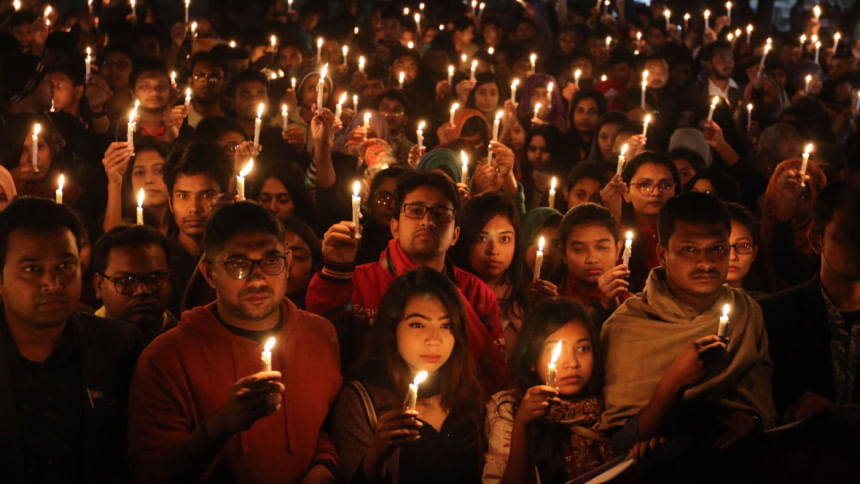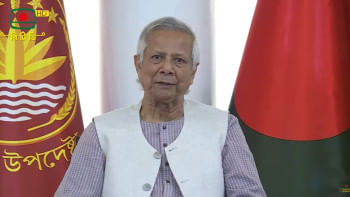We have laws but why don’t they work?

This year's International Women's Day, as the ones before it, comes with a reminder that the culture of impunity for violence against women (VAW) continues to be a concern, despite there being a myriad of laws that are meant to counter VAW in our country.
Originally, the Penal Code 1860, which was passed by the British colonial rulers and subsequently retained by Bangladesh upon independence, dealt with the majority of crimes including most forms of violence against women (except, for instance, child marriage). Two decades after our independence, lawmakers actively started passing special laws to counter violence against women (all of which still remain in force, save the first three): the Dowry Prohibition Act in 1980 (now repealed), the Cruelty to Women (Deterrent and Punishment) Ordinance in 1983, the Nari o Shishu Nirjatan Daman (Bishesh Bidhan) Ain in 1995, Nari o Shishu Nirjatan Daman Ain in 2000, Acid Violence Act in 2002, Domestic Violence (Prevention and Protection) Act in 2010, Prevention and Suppression of Human Trafficking Act in 2012, Pornography Control Act 2012, Child Marriage Restraint Act in 2017, and Dowry Prohibition Act in 2018.
This trajectory of laws will give the impression that countering violence against women has always been a priority for successive governments. So the question that naturally arises is: if we have so many laws that seek to eradicate violence against women in all its forms, then why are incidents still so high?
One of the major obstacles in measuring the effectiveness of legal intervention vis-à-vis violence against women is the fact that there are no national official statistics on crimes that constitute such violence in Bangladesh (for example, rape, domestic violence, etc.). Even if such statistics are there, those have not been made publicly accessible. While some statistics have been disclosed in government reports or ad hoc press statements by government officials (e.g. the total number of rape cases filed between 2014 and 2017), the data is typically a lump sum and not disaggregated. Similarly, while the official Bangladesh Police website does provide crime statistics which is disaggregated by year, it lumps, rather unhelpfully, all violence against women cases under an umbrella category termed "woman and child repression" cases (presumably denoting the total number of cases filed under the Nari o Shishu Nirjatan Daman Ain 2000). This figure could easily be (and should be) disaggregated by the specific type of crime and the district in which it was committed. Additionally, although the Ministry of Women and Children Affairs, in furtherance of the multi-million dollar Multi-Sectoral Programme on Violence Against Women (MSPVAW), was meant to develop a National Database on Violence Against Women, it is now in its twentieth (and penultimate) year of operation, and the database is still said to be "under construction" on the official MSPVAW website.
Therefore, we have to rely on unofficial statistics, such as that of rights bodies like Ain O Salish Kendra (ASK) which primarily records rape statistics on the basis of scanning nine daily newspapers in the country. ASK statistics for rape in 2019 (1413) is nearly double that of 2018 (732). We do not know if this is because the number of rape incidents actually doubled across the country, or whether the nine newspapers that ASK scans just so happened to report rape incidents with more frequency (because, for instance, sexual violence was more topical in 2019 than 2018 due to the much-discussed case of Nusrat Jahan Rafi). Therefore, it is imperative that the government should provide us with official rape statistics by launching the much-anticipated VAW database and disaggregating the police cases as aforementioned.
Despite the data gap, there are obvious hurdles in our legal system that prevent VAW victims from seeking justice. First and foremost, our institutions, which serve as the entry point for victims who wish to seek justice, lack gender sensitivity. For most VAW victims, going to a mostly male (if not all-male) police station to report and narrate the details of the crime, especially if it is of a sexual nature, is a daunting experience. This is typically followed by intrusive and intimate medical exams in crowded rooms, which often take place without the victim's express and informed consent. Second, due to the social stigma attached, victims of VAW wish to have a quick and discrete remedy. Filing court cases does the exact opposite: it goes on for years, if not decades, due to seemingly endless adjournments and deferred hearings due to non-appearance of witnesses and it has a tendency to generate publicity. Third, even if a VAW victim is willing to battle years of litigation, they may face threats to their safety from the perpetrator's side (who are typically more powerful) and constantly live under fear of reprisal and revenge due to the lack of a victim protection system. Fourth, if the trial does proceed smoothly, the unabashed moral policing of victims by the defence in an open court may make the victims feel as though they have been put on trial, and not the accused perpetrator.
It is clear, therefore, that the process of seeking justice is re-traumatising for a VAW victim throughout. The first problem can only be solved through thorough and comprehensive gender sensitivity training of police officers and relevant medical professionals and ensuring the presence of round-the-clock female police officers and social workers. An online complaints mechanism could also be developed whereby victims can submit their first information report (FIR) in writing. The solution to the second problem already exists to a large extent in the Nari o Shishu Nirjatan Daman Ain 2000, as it mandated that all VAW trials be concluded within 180 days, while it also introduced closed-door examination of rape victims by the court. Neither of these are met in practice. Furthermore, camera trials could be introduced for VAW cases. The third problem can be mitigated if the Witness and Victim Protection Law, which was drafted by the Law Commission 14 years ago, is finally passed and a witness protection scheme is activated at the upazila level. The fourth problem can be solved by prohibiting the admissibility of character evidence in VAW cases by amending the Evidence Act 1872 accordingly. Finally, the data gap must be overcome if we wish to be able to meaningfully measure successes in countering VAW.
However, if patriarchal social norms continue to remain in place, no amount of legal intervention can ever truly address violence against women. However, the solutions proposed to the four key problems presented above will go a long way in at least piercing the longstanding culture of impunity.
Taqbir Huda is a Research Specialist at Bangladesh Legal Aid and Services Trust (BLAST), where he leads the Rape Law Reform Now campaign.
Email: [email protected]

 For all latest news, follow The Daily Star's Google News channel.
For all latest news, follow The Daily Star's Google News channel. 



Comments